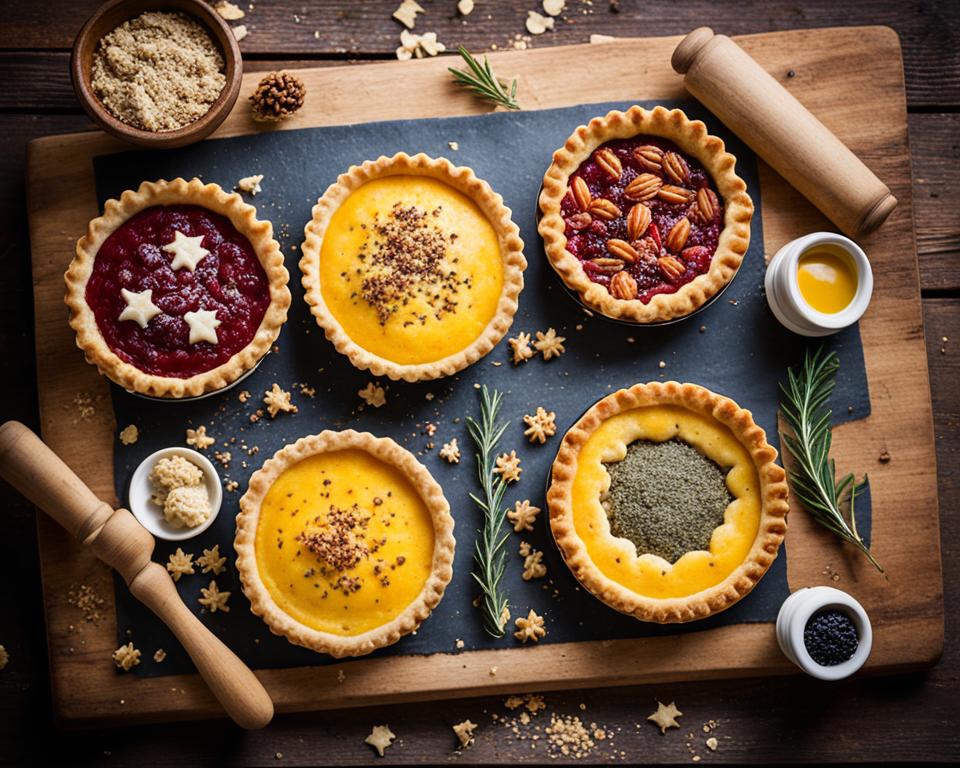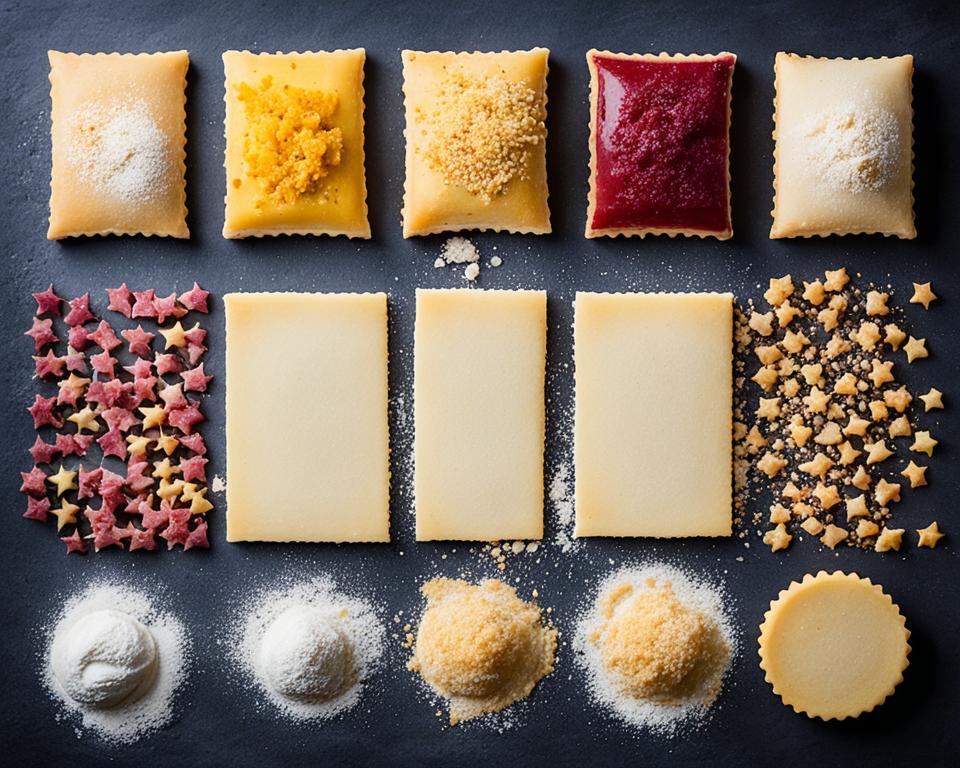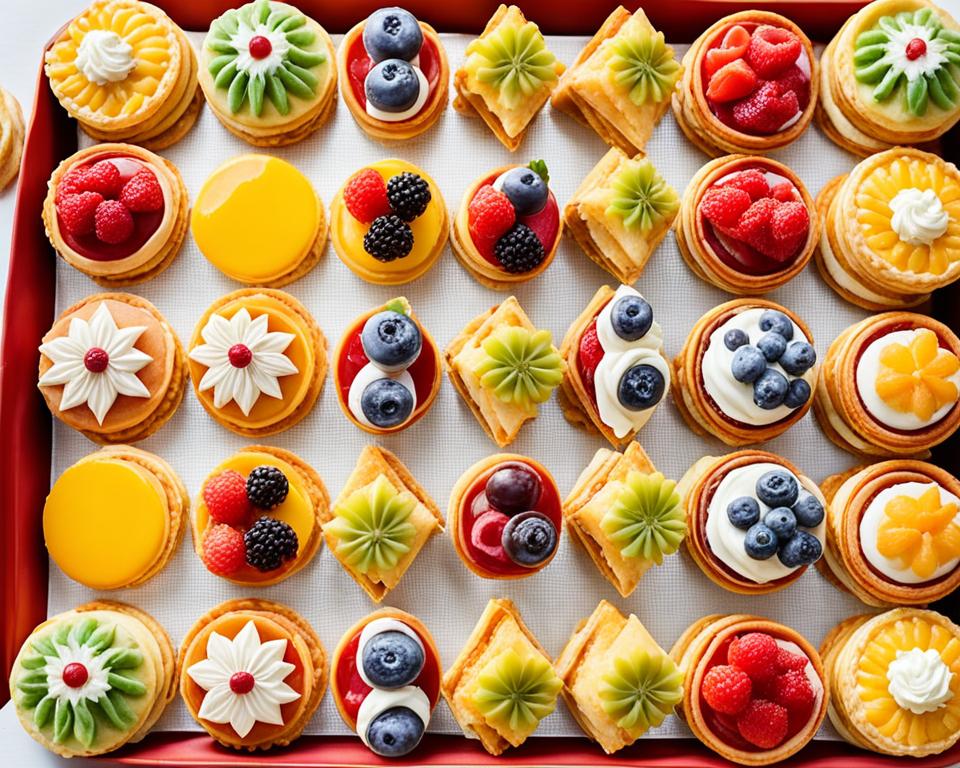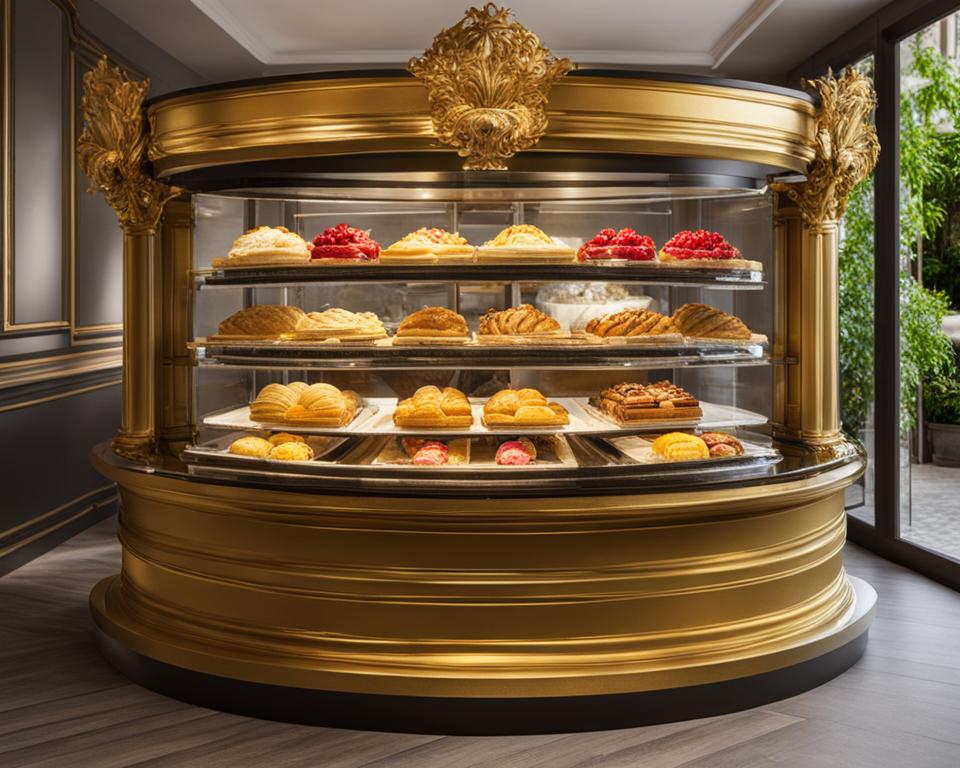Knowing your way around the kitchen comes with understanding the basics of easy pastries. Right in the heart of this lies the beauty and simplicity of shortcrust pastry – a champion among basic pastries and one of the most commonly used pastries the world over. Its minimalistic approach, calling for nothing more than flour, fat, salt, and water, has made it a perennial favorite, one that sits at the core of countless pie crusts, tarts, and quiche bases. The advent of shortcrust pastry has marked an essential milestone for baking enthusiasts, defining the genre of accessible culinary creations.
Key Takeaways
- Shortcrust pastry is a foundational recipe in the realm of baking, revered for its ease of preparation.
- With its short list of ingredients, shortcrust aligns with the values of minimalism and accessibility in home baking.
- The versatility of shortcrust pastry is reflected in its use for both sweet and savory dishes.
- This pastry type is an ideal starting point for novices looking to delve into the art of pastry making.
- Being a commonly used pastry, shortcrust offers an opportunity to master the essential techniques in pastry formation.
- Its popularity stems from the ability to achieve a tender, flaky finish, a textural component desired by many baking traditions.
The Basics of Pastry: Understanding Ingredients and Types
Embarking on a culinary journey through the world of pastries begins with grasping the basic elements that compose this delightful category of food. Renowned for their rich flavors and enticing textures, pastries are a staple in many cultures, providing a canvas for an array of sweet and savory delights. Delve into the components that construct the very foundation of the most popular pastries and explore the subtleties that differentiate them from curiously similar baked goods like bread.
Defining Pastry and Its Essential Components
At its core, pastry epitomizes the alchemy of kitchen essentials: flour, fat, water, sugar, milk, and eggs merge to craft an assortment of pastry variations that tease the palette. Whether it’s a sumptuous fruit tart or a hearty meat pie, the essential components of pastry play pivotal roles in determining the end product’s texture, flavor, and structural integrity. In the hands of a skilled baker, these rudimentary ingredients are transformed into quick pastries and ornate confections alike.
Comparative Overview of Pastry and Bread
Contrary to the lofty, gluten-rich constitution of bread, pastry distinguishes itself with a higher fat content which imparts the coveted flaky or crumbly texture. This fundamental disparity lies in pastry’s reliance on shortening that, when deftly folded or blended into the dough, prevents the gluten from forming extensive networks. Hence, pastries incarnate as lighter and more indulgent affairs compared to their bread counterparts.
Key Features of a Quality Pastry
Discerning pastry aficionados can agree: the hallmarks of a quality pastry lie in its lightness, flakiness, and buttery richness. Mastery over these characteristics hinges upon a careful balance of mixing and chilling—the latter ensuring that fat remains distinct within the flour matrix, creating the layers that puff and flake in the heat of the oven. It’s these enticing textures that help elevate pastry to the pinnacle of baked delights.
Embracing the simplicity of pastries is not just an exercise in baking; it’s an artful pursuit that invites a tapestry of culinary expression.
- Flour: the building block that provides structure and substance.
- Fat: key to creating the tender, flaky layers distinctive of pastries.
- Water: hydrates the flour, activates gluten (to the desired extent), and contributes to the leavening process.
- Sugar: adds sweetness and contributes to the browning and texture.
- Milk: enriches the dough and adds color to the crust when baked.
- Eggs: provide stability, richness, and contribute to the leavening.
In the hands of a skilled baker, these six ingredients are the stepping stones to an endless variety of quick pastries and elaborate dessert items. A pastry’s quality is not just defined by what goes into it, but also by the care and method applied in its preparation—a dance of precision and patience befitting the world’s most beloved baked treasures.
What is the simplest and most common pastry?
When it comes to pastries, one variety stands out for its simplicity and ubiquity: shortcrust pastry. This staple is widely acknowledged as the simplest and most common pastry, unpretentiously blending the fundamentals of baking to create a versatile base for both sweet and savory dishes. Shortcrust pastry has won the hearts of home cooks and professional chefs alike by offering an accessible entry point into the world of baking.

The making of shortcrust pastry is as straightforward as its ingredients list. By intricately weaving together flour and fat—often butter, lard, or a combination of both—you obtain a crumbly mixture. Water then enters the equation, bringing the components into a cohesive dough that promises to roll out smoothly and bake to perfection. Yet, the true secret to its famously tender, flaky consistency lies in the delicate process of chilling and resting the dough before it meets the oven.
Exemplifying the essence of basic pastry skills, shortcrust pastry is celebrated for its unassuming charm and culinary dependability. Whether employed in the creation of a classic apple pie, lemon tart, or savory quiche, this pastry acts as a canvas for an array of fillings. Its fundamental beauty shines in how it enhances the featured ingredients while maintaining a delectable identity of its own.
- Iconic for its ease in preparation and pliability in shaping
- Key component for pies, tarts, quiches, and more
- Requires minimal ingredients for a classic, homemade feel
- Cherished for its flaky texture and rich, buttery taste
The key to successful shortcrust pastry is not only in the ingredients but in the method of preparation. Bakers worldwide advice patience and attention to detail when it comes to chilling the dough, ensuring that every bite offers that signature flakiness. Hence, shortcrust pastry holds its revered place as the simplest and most common pastry—a testament to the joy and artistry of baking.
Embrace the simple pleasures of shortcrust pastry and unlock the doorway to an immense variety of delectable creations.
Exploring Shortcrust Pastry: A Beginner-Friendly Option
Stepping into the realm of baking, one encounters the charm and simplicity of shortcrust pastry. As a versatile and accessible choice, it appeals especially to those just kindling their passion for baking. Shortcrust pastry distinguishes itself from the myriad of basic pastries with its straightforward mixture of butter and flour. This section will guide novices through the pleasant path of crafting what many consider the starting point of beginner-friendly pastries.
The Classic Method of Creating Shortcrust Pastry
The creation process of shortcrust pastry starts with a harmonious blend of flour and fat, a step that sets the foundation for the texture of the dough. Butter, notable for its richness, or lard, celebrated for its flakiness, is enhanced by just a pinch of salt and the addition of water to bind the mixture into a dough. The appealing part of this process is the flexibility it provides, making it ideal for experimentation by baking enthusiasts striving to grasp the essentials of basic pastries.
Chilling and Rolling: Essential Steps in Pastry Making
After mixing, the dough enters a critical chilling phase. This step is not merely a pause in the process but a strategic maneuver to solidify the fat, resulting in a dough that rolls out with clarity of purpose. Chilling presents an interlude where aromas meld and textures are promised.
The subsequent rolling phase is where precision plays its part—the even, tender pressure that transforms the chilled dough into sheets ready to welcome a melange of fillings. Here, one appreciates the forgiving nature of shortcrust, as it permits handling without leading to toughness, affirming its status as the perfect introductory pastime for pastry enthusiasts.
The essence of shortcrust pastry lies in its welcoming nature, inviting beginners to immerse themselves in the tactile joys of a tradition cherished by generations.
Varieties of Pastry: From Flaky to Puff
The domain of baking is rich with pastry variations that tantalize taste buds around the globe, each distinct in its preparation and purpose. Among these, some have climbed the ranks to become the most popular pastries in both professional patisseries and home kitchens.
Flaky pastry, known for its buttery layers that separate during baking, creates a texture that’s both crisp and tender. This pastry’s secret lies in the method of layering fat and dough to introduce air pockets that puff when exposed to oven heat. A mainstay in the realm of savory pies and turnovers, flaky pastry combines practicality with a luxurious mouthfeel.
Puff pastry is another charismatic player in the pastry world, notable for its delicate, airy layers. A marvel of the baking world, it rises through myriad laminated layers of dough and butter. When heat works its magic on puff pastry, the moisture from the butter releases steam, causing the pastry to ‘puff’ and resulting in a flaky, sumptuous treat that is both versatile and supremely satisfying.
This culinary journey would be incomplete without the mention of choux pastry, the foundation for delicacies such as éclairs and cream puffs. Light and airy, yet strong enough to hold luscious creams, a well-executed choux transforms simple ingredients into a pastry of elegance and complexity.
Phyllo dough contrasts starkly with its pastry counterparts by boasting a paper-thin persona. This requires a baker’s patience and careful handling. Layers of phyllo, meticulously brushed with butter and often filled with sweet or savory mixtures, bake up into pastries that are both flaky and ethereal — a testament to the art of subtlety in baking.

In summary, each variety of pastry from the popular flaky type to the refined sheets of phyllo, offers a different textural and sensory experience. Whether one seeks the richness of puff pastry or the delicate crispness of phyllo, these palettes of pastry variations provide endless possibilities for both the experienced chef and the curious home baker.
“Each pastry holds a story, a myriad of layers and flavors that, when blended together, provide a symphonic taste experience that is both memorable and unique.”
- Flaky Pastry: Rich and crumbly, a marvel for quick eats and rustic pies.
- Puff Pastry: An epitome of finesse, ideal for elegant desserts and sophisticated hors d’oeuvres.
- Choux Pastry: Light and hollow, a canvas for the most luxurious of cream fillings.
- Phyllo Dough: Crisp and delicate, encapsulating sweet and savory with a whisper-thin touch.
The Art of Perfecting Choux and Phyllo Pastries
Embarking on the journey of mastering easy pastries, one must consider the artful practices behind choux and phyllo doughs. These irreplaceable staples occupy a sweet spot in the pantheon of pastry variations; their ability to transcend simple ingredients into sublime forms of dessert command both reverence and meticulous technique.
The Unique Process of Making Choux Pastry
Choux pastry, a pillar among easy pastries, is uniquely crafted by cooking the dough before baking. Stirring flour into a mixture of water and melted butter, the pastry chef creates a base that feels paradoxically dense and light simultaneously. It is this base that, with the addition of beaten eggs, becomes the magnificently light and airy foundation poised to be filled with cream and turned into sumptuous éclairs and profiteroles.
Unlike many pastry variations that depend on cold fat to create texture, choux pastry balloons from the high moisture content that, upon heating, turns into steam and puff up the dough. The end result is a delicate balance: a hollow center amidst a buoyant, golden crust that cradles a creamy heart.
Delicate Layers: Working with Phyllo Dough
On the other end of the spectrum, phyllo dough demands a contrasting approach. Fine layers, nearly translucent, are a hallmark of pastries like baklava and spanakopita. Buttering each sheet meticulously, the baker layers the phyllo, wrapping it around flavorful fillings, to craft pastries known for their flaky finish and ethereal texture.
Working with phyllo teaches patience and precision. Understanding the dough’s propensity for drying requires swift hands and an organized method. Through this rigorous process, the seemingly simple act of layering dough and fat evolves into a textile-like craft, weaving together buttery strata to construct paper-thin delicacies.
| Pastry Type | Texture | Key Ingredients | Common Uses |
|---|---|---|---|
| Choux | Light, airy, hollow | Butter, Water, Flour, Eggs | Éclairs, Cream Puffs, Profiteroles |
| Phyllo | Flaky, delicate, crisp | Flour, Water, Starch, Butter | Baklava, Spanakopita, Strudels |
The pursuit of perfecting choux and phyllo pastries is both a testament to the baker’s skill and an echo of the diverse offerings within the world of easy pastries. Each pastry, steeped in tradition and crafted with dedication, offers a distinct experience—a whisper of crispness, or a tender bite leading to a creamy surprise.
Exploring the realms of choux and phyllo dough not only diversifies one’s pastry repertoire but also enhances the appreciation for the delicate interplay between texture, flavor, and technique in the world of baking.
Conclusion
The journey into pastry making is an exploration of culinary creativity, welcoming both beginners and established chefs to a world where tradition meets innovation. The art of creating easy pastries provides a fulfilling avenue for self-expression and serves as a testament to the timeless allure of baking. Within this realm, shortcrust pastry emerges as a cherished staple, a beginner-friendly pastry that acts as the key to unlocking the abundant treasures of the baking universe. Its fundamental role in the pantheon of pastries underscores the joy and simplicity intrinsic to the craft.
The Joy of Pastry Making for Beginners and Pros Alike
For novices, the allure of crafting easy pastries begins with the gratifying process of working with shortcrust, a pastry forgiving of errors and rewarding in its results. The tactile pleasure of blending, rolling, and shaping speaks to the very essence of beginner-friendly pastries. Meanwhile, seasoned pros revisit shortcrust for its dependable nature and endless versatility, often innovating on its classic base to create new, mouthwatering interpretations. This unpretentious dough bridges the gap between simplicity and complexity, proving that the foundations of great baking are accessible to all.
Why Shortcrust is the Gateway to Baking Success
Shortcrust pastry, in its humble composition and ease of manipulation, is rightly celebrated as the gateway to baking mastery. For those embarking on their baking journeys, mastering this quintessential dough lays the groundwork for a future filled with flaky pies, sumptuous tarts, and delectable quiches. It demonstrates that armed with the knowledge of basic pastries, one can reach the zenith of culinary creation, where both the rustic charms of home-style baking and the refined touches of gourmet desserts are within reach. Shortcrust pastry is more than just a starting point—it’s the path to a world where the only limit is the baker’s imagination.
FAQ
What is the simplest and most common pastry?
The simplest and most common pastry is shortcrust pastry. Known for its ease and versatility, it consists of flour, fat, salt, and water, and is used as the base for many pies, tarts, and quiches.
What are the essential components of pastry?
The essential components of pastry typically include flour, fat, water, and sometimes sugar, milk, and eggs. These ingredients are blended in various ways to create different types of pastries, from flaky to puff to choux and phyllo.
How does pastry differ from bread?
Pastry differs from bread primarily in its higher fat content, which contributes to its flaky or crumbly texture. While bread requires the development of gluten for its structure, pastry making is focused on incorporating fat to limit gluten formation and maintain tenderness.
What are the key features of a quality pastry?
A quality pastry typically has a tender, flaky texture with a buttery flavor. It should be light and airy with layers that are well-defined but not tough or rubbery. The moisture content should be balanced enough to hold the pastry’s shape without being too wet or dry.
How is shortcrust pastry made?
Shortcrust pastry is made by mixing fat (such as butter or lard) with flour until the mixture resembles breadcrumbs. Then, cold water is added to bind the dough. After it comes together, the dough is chilled before being rolled out, which helps maintain its flaky texture when baked.
Why is chilling and rolling important in pastry making?
Chilling the dough before rolling it out helps to solidify the fat, which prevents the pastry from becoming too tough when baked. Rolling the dough evenly contributes to a consistent texture and ensures that the pastry cooks uniformly, resulting in a better overall quality.
What are some popular pastry variations?
Popular pastry variations include flaky pastry, which is light and airy; puff pastry, known for its buttery layers that puff up during baking; choux pastry, which puffs up to a hollow shell ideal for filling; and phyllo dough, which consists of thin, delicate layers that are flaky and crisp.
How is choux pastry unique?
Choux pastry is unique in that it is made with a cooked dough that includes water, milk, butter, and flour. Eggs are then beaten into the dough, which is piped into shapes and baked until puffy. It expands through the steam created during baking, resulting in a hollow center perfect for sweet or savory fillings.
What are the challenges when working with phyllo dough?
The main challenge when working with phyllo dough is handling the paper-thin layers without tearing them. Each layer must be carefully buttered before being layered or wrapped around a filling. It requires a gentle touch and attention to detail to maintain the integrity of the layers for a crisp, flaky finish.
Why is shortcrust pastry considered the gateway to baking success?
Shortcrust pastry is considered the gateway to baking success because it is simple to make and incredibly versatile. It provides a solid foundation to learn essential baking skills and techniques that can be applied to more complex pastry making. Its forgiving nature makes it ideal for beginners to experiment with, leading to a broader understanding and enjoyment of baking.




